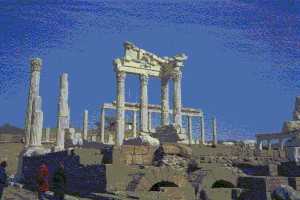| Beliefs characterized
by multiple deities, local temples and festivals, and the divinity
of the emperor. |
 |
|
Temple
to Emperor Trajan at Pergamum
|
The Greeks, Romans,
and other peoples in the Roman Empire worshiped multiple deities. Traditional
deities: the chief male god was named Zeus in Greek and Jupiter in Latin;
the goddess of beauty and love was Aphrodite or Venus; the god of wine
was Dionysus or Bacchus; and the god of healing was Aesclepius. Cities
typically had several temples, each dedicated to a god or goddess. These
deities were honored by civic festivals and public processions, as well
as by the sheep and oxen that the priests sacrificed. In contrast to Greco-Roman
religion, both Christianity and Judaism taught
that there was only one true God. Belief that God was revealed in Jesus
Christ, however, set church members apart from Jews as well as from Greeks
and Romans. Emperor worship: some, but not all, Roman emperors were regarded
as gods; emperors were usually given divine status after their deaths,
although a few were considered gods during their lifetimes. Cities built
temples to the emperors in order to show their loyalty. In return for
their loyalty these cities received help and prestige from the Roman authorities.
Christians agreed to pray for the well-being of the emperor, but refused
to worship the emperor as a god. Their refusal sometimes led to persecution.
|